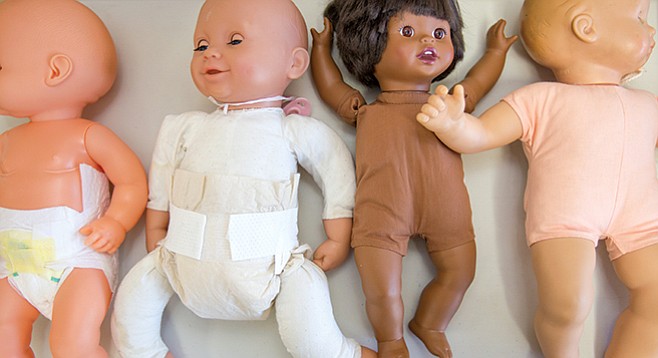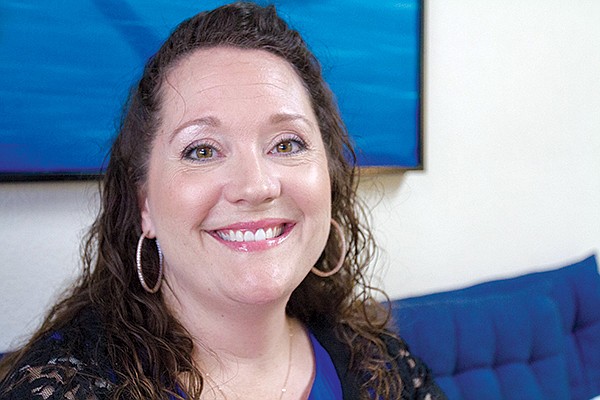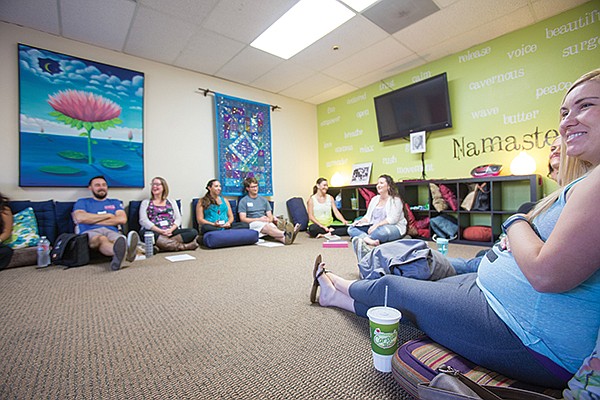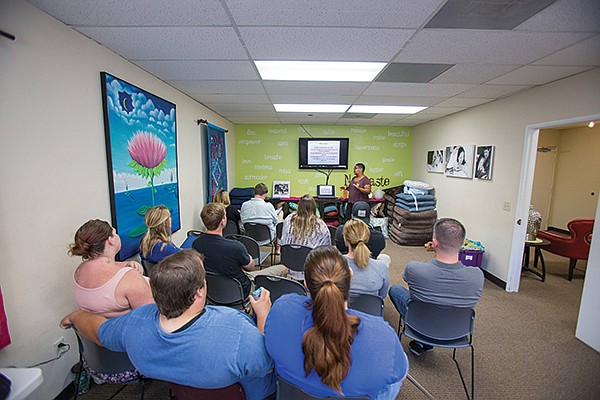 Facebook
Facebook
 X
X
 Instagram
Instagram
 TikTok
TikTok
 Youtube
Youtube


Nikki Helms was elated when she received word that she’d been accepted into the Sharp Mary Birch doula program. A doula since 2003 and currently also a student midwife, she believed the hospital’s endorsement could put her in a favorable position to bring in a steady client base for her doula practice.
“My personal excitement was about the privilege of being in this very small, select group of women who have been trained and interviewed to be associated with this hospital,” she says.
But in the hospital’s eight-hour training course for doulas who’d been accepted into the program, what she heard “made me question my ability to practice,” she says.
We’re sitting in the comfy, cushiony waiting area at the Birth Education Center of San Diego in Mira Mesa. Photographs of happy pregnant women, newborn babies, and dewy-eyed fathers adorn the surfaces around the small room. The door to an adjacent classroom stands open revealing large pillows in place of traditional classroom seating. Depending on the day, the pillow room fills with women learning everything from hypnobirthing to breast feeding to “belly dancing for labor.”
This morning, the Center is dim and quiet. Its founder, Care Messer, has been held up elsewhere and is unable to join us in person. Earlier, Helms expressed discomfort in holding this meeting without Messer, an outspoken doula and hypnobirthing instructor whose name comes up often in the San Diego natural birth community. So Messer joins us via speakerphone.

To understand Helms’s story, it’s important to understand what a doula is. According to DONA International (formerly Doulas of North America), the largest nonprofit organization that trains and certifies doulas, “doula” refers to “a trained and experienced professional who provides continuous physical, emotional, and informational support to the mother before, during, and just after birth; or who provides emotional and practical support during the postpartum period.”
DONA says a birth doula’s job includes staying with the woman during labor; providing “emotional support, physical comfort measures, and an objective viewpoint, as well as helping the woman get the information she needs to make informed decisions”; and facilitating communication between the laboring woman, her partner, and her clinical care providers.
“It’s really important that you have someone that’s able to put that time in with you. You want to have that intimate relationship with someone who is going to be there with you continually,” Helms says. “The same is true for hospitals as it is for birth centers. You may see the same midwife in the course of your care, but on the day you go into labor, if she’s not on call, then you don’t have that continuity of care. They’re going to give you good care regardless, but your doula is there next to you the whole time.”
A DONA birth doula certification requires a 16-hour workshop every four years, in addition to extensive reading and resource development work. “The number of hours a doula can put into her initial certification can vary on how busy the doula is,” Helms says. “There are essays to write, books to read, and if she’s a doula with young children she can find herself up against their DONA-stated four-year time limit pretty quickly.”
Doulas can practice in three different ways: as private hires, as hospital or birth center volunteers, or as hospital employees. University of California San Diego Health System offers the Hearts and Hands doula program, and Best Start.
“There are several places that offer volunteer doulas [in San Diego]. UCSD has a volunteer doula program, and they’re fantastic. The doulas that are there, most of them work in the birth center, but they will come to you if you’re on the labor and delivery floor,” Helms says.
Best Start Birth Center provides a volunteer doula for women who can catch one on-call during the labor process, but they also have a low-cost doula referral program for those who want to hire a doula earlier in the pregnancy. All are DONA-certified.
Most for-hire doulas work with women in home birth, birth center, and hospital settings. Occasionally, friction occurs between doulas and nurses and doctors in hospitals, Messer and Helms say. But they agree that the more familiar everyone becomes with each other’s role the less friction arises.
“I’ve worked with families in hospitals and in birth centers and in home births,” Helms says. “Sharp Mary Birch has been the one hospital that has made it more difficult. Other hospitals, other establishments have made it easier for doulas to be a part of the birth team.”
But even knowing this, Helms applied for and interviewed for a position on the hospital’s now-18-month-old doula program. “I went into the program in the hopes in the back of my mind that I would be able to help women and affect change and be a strong advocate for natural birth, because I believe we were made to do that,” she says.
She interviewed and then waited weeks to hear back. When she was chosen to be one of the nine doulas currently on Mary Birch’s website, she was thrilled.
Until she sat through the training. “As I’m listening during the course of the day, I’m hearing all these things about how women are not being empowered to labor and deliver under their own power. I’m realizing that as much work as they’ve done to be baby friendly, they’re not actually Mama friendly.”

Messer suggests that the Sharp Mary Birch doula program is little more than a smart marketing ploy. Their website makes it a point to emphasize that their doulas are DONA-certified and that “doula-supported labors result in reduced use of intravenous pain medication and a decreased need for epidurals.”
“I think what Sharp thinks is if they have a doula program, it will attract so many moms that will hire their doulas,” Messer says. “It’s good PR for them.”
Below the surface, however, the two say the program strips away a doula’s ability to do her job the way she’s been trained to do it. Messer says one doula texted her during the training and summed up the program for her. “They basically said, ‘You’re supposed to help the nurse. If the nurse says get an epidural, get an epidural.’”
The DONA code of ethics reads, “The doula’s primary responsibility is to her clients,” and both Messer and Helms believe that this goes against the policies and procedures at Mary Birch.

On one hand, the hospital has the right to expect its employees to conform to policies, procedures, and staff hierarchies. But doulas in their program are actually paid by the parents. Their website makes this clear, “The $900 fee for doula services will be billed directly to you and is not typically covered by insurance.”
Helms has no problem with the referral system, but she does believe expectant mothers who sign on with the Mary Birch doula program are not getting what they’re paying for. “You as the customer/client are not getting the full benefit of training and experience of the person you’re hiring because they’re being sequestered by that particular hospital system,” Helms says.
“That’s the rub of it. They’re paid as an independent contractor by the patient, but as an employee, they can’t give them all the information,” Messer explains. “If the nurse says you have to have an epidural, then that’s what we’re going with. If I’m working for them [as a doula in their program], and I say, ‘Hey Mom, do you guys want to think about that for a second?’ and they say, ‘Yes,’ and I stay in the room and they choose not to get an epidural, then who’s going to get fired? Me, because I suggested that there were other alternatives.”
Messer cites intermittent (versus hospital-favored constant) monitoring as well as eating and drinking during labor among the choices a doula can offer from outside the Mary Birch program that could get her fired if she signs on with them. “[Leaving the program] would open up all these options of things [a doula] could say and empower the mom with, [which] she couldn’t have done 15 minutes before when she was an employee,” Messer says, “even though [as an employee] she was paid by this mom the whole time.”
Mary Birch responded through its public relations department, which wrote, “Patient feedback on our doula program has been overwhelmingly positive.”
Regarding the question of allowing women in labor to eat, Mary Birch stated, “We ask that laboring moms avoid eating and drinking as this presents a safety issue during emergent situations.”
The question Messer believes Moms should ask about doulas in the Mary Birch program is, “Are they going to advocate for me, or are they going to follow the rules of the hospital?”
Messer says she has had good experiences working with mothers at Mary Birch as an outside doula. “I’ve had very good births at Mary Birch. But as a doula, I go in very mellow. I get my parents in there at the very end, and we work with the staff, not against the staff,” she says. “I think there are some rogue doulas out there who think they’re God. They go in thinking, ‘I have to take on the hospital for this mom,’ and that’s not what the doulas are supposed to do.”
The Mary Birch website explains that while outside doulas are “welcome,” one benefit to choosing one of their doulas is that, “This program helps to take the work out of researching, interviewing, and hiring qualified doulas and acquainting them with hospital staff and procedures.” Messer claims that this message merely pays lip service to the idea of providing options to families. When her clients plan to give birth at Mary Birch, Messer works with them at home for as long possible before going into the hospital. “The doula’s role is continual support,” she says. “My job is to keep him fed, them both going to the bathroom and eating, whatever. As soon as we get to the front desk at Mary Birch, security guard says, ‘Mom plus one.’ Mom now has to pick between her doula who is helping support her through this whole process or her partner.”
Her voice rises with indignation that’s evident through the speakerphone in Helms’s hand. “Well, dad’s not going to miss the birth. So now they’ve separated us,” she says. “But if they’ve hired a Mary Birch doula, they’re an employee. They can come right up with you, and you can have continual support the whole time. So the message is, ‘If you don’t hire one of our doulas, you’re not going to have the support that you need to have a beautiful birth.’” But even the privilege of having access to her clients through the triage process is not enough to make Messer want to sign on with Mary Birch’s doula program.
Why not?
“Because it limits the parents’ options,” she says.
Beyond the privilege of having access to clients through the triage process, why would a doula want to sign on for their program?
“Money,” says Messer. “Money, because some doulas have a hard time getting regular clients, and if the hospital is [promoting] you out to ready-made people right there who are considering a doula, you’re going to get $800 right off the bat. Even in regular practice if you haven’t done many births, you might get $400 or $500 until you build up your experience, but now you’re going to get $800.”
Messer also says some doulas sign on hoping to elicit change. “[Some doulas think] ‘If I get into the hospital, I can start making changes for doulas everywhere,’” she says, “But then once they got into the training, it’s like, ‘Wow, I can’t labor with them at home. Wow, I can’t give them options that they can eat and move around. I can’t let them know that they can have intermittent monitoring.’”

Helms admits that she thought she could change things from the inside. But once she saw what she was up against, she decided she would be better off using her energy elsewhere.
“I tried to figure out if I should suck it up and push through, because I really wanted to try and help these women,” she says. But she decided it was “going to be a continual fight against the system. And how much will that take out of me as a person, and how much will that affect how I practice? So, I said, ‘It’s been lovely. Thanks very much. I gotta go.’”



Nikki Helms was elated when she received word that she’d been accepted into the Sharp Mary Birch doula program. A doula since 2003 and currently also a student midwife, she believed the hospital’s endorsement could put her in a favorable position to bring in a steady client base for her doula practice.
“My personal excitement was about the privilege of being in this very small, select group of women who have been trained and interviewed to be associated with this hospital,” she says.
But in the hospital’s eight-hour training course for doulas who’d been accepted into the program, what she heard “made me question my ability to practice,” she says.
We’re sitting in the comfy, cushiony waiting area at the Birth Education Center of San Diego in Mira Mesa. Photographs of happy pregnant women, newborn babies, and dewy-eyed fathers adorn the surfaces around the small room. The door to an adjacent classroom stands open revealing large pillows in place of traditional classroom seating. Depending on the day, the pillow room fills with women learning everything from hypnobirthing to breast feeding to “belly dancing for labor.”
This morning, the Center is dim and quiet. Its founder, Care Messer, has been held up elsewhere and is unable to join us in person. Earlier, Helms expressed discomfort in holding this meeting without Messer, an outspoken doula and hypnobirthing instructor whose name comes up often in the San Diego natural birth community. So Messer joins us via speakerphone.

To understand Helms’s story, it’s important to understand what a doula is. According to DONA International (formerly Doulas of North America), the largest nonprofit organization that trains and certifies doulas, “doula” refers to “a trained and experienced professional who provides continuous physical, emotional, and informational support to the mother before, during, and just after birth; or who provides emotional and practical support during the postpartum period.”
DONA says a birth doula’s job includes staying with the woman during labor; providing “emotional support, physical comfort measures, and an objective viewpoint, as well as helping the woman get the information she needs to make informed decisions”; and facilitating communication between the laboring woman, her partner, and her clinical care providers.
“It’s really important that you have someone that’s able to put that time in with you. You want to have that intimate relationship with someone who is going to be there with you continually,” Helms says. “The same is true for hospitals as it is for birth centers. You may see the same midwife in the course of your care, but on the day you go into labor, if she’s not on call, then you don’t have that continuity of care. They’re going to give you good care regardless, but your doula is there next to you the whole time.”
A DONA birth doula certification requires a 16-hour workshop every four years, in addition to extensive reading and resource development work. “The number of hours a doula can put into her initial certification can vary on how busy the doula is,” Helms says. “There are essays to write, books to read, and if she’s a doula with young children she can find herself up against their DONA-stated four-year time limit pretty quickly.”
Doulas can practice in three different ways: as private hires, as hospital or birth center volunteers, or as hospital employees. University of California San Diego Health System offers the Hearts and Hands doula program, and Best Start.
“There are several places that offer volunteer doulas [in San Diego]. UCSD has a volunteer doula program, and they’re fantastic. The doulas that are there, most of them work in the birth center, but they will come to you if you’re on the labor and delivery floor,” Helms says.
Best Start Birth Center provides a volunteer doula for women who can catch one on-call during the labor process, but they also have a low-cost doula referral program for those who want to hire a doula earlier in the pregnancy. All are DONA-certified.
Most for-hire doulas work with women in home birth, birth center, and hospital settings. Occasionally, friction occurs between doulas and nurses and doctors in hospitals, Messer and Helms say. But they agree that the more familiar everyone becomes with each other’s role the less friction arises.
“I’ve worked with families in hospitals and in birth centers and in home births,” Helms says. “Sharp Mary Birch has been the one hospital that has made it more difficult. Other hospitals, other establishments have made it easier for doulas to be a part of the birth team.”
But even knowing this, Helms applied for and interviewed for a position on the hospital’s now-18-month-old doula program. “I went into the program in the hopes in the back of my mind that I would be able to help women and affect change and be a strong advocate for natural birth, because I believe we were made to do that,” she says.
She interviewed and then waited weeks to hear back. When she was chosen to be one of the nine doulas currently on Mary Birch’s website, she was thrilled.
Until she sat through the training. “As I’m listening during the course of the day, I’m hearing all these things about how women are not being empowered to labor and deliver under their own power. I’m realizing that as much work as they’ve done to be baby friendly, they’re not actually Mama friendly.”

Messer suggests that the Sharp Mary Birch doula program is little more than a smart marketing ploy. Their website makes it a point to emphasize that their doulas are DONA-certified and that “doula-supported labors result in reduced use of intravenous pain medication and a decreased need for epidurals.”
“I think what Sharp thinks is if they have a doula program, it will attract so many moms that will hire their doulas,” Messer says. “It’s good PR for them.”
Below the surface, however, the two say the program strips away a doula’s ability to do her job the way she’s been trained to do it. Messer says one doula texted her during the training and summed up the program for her. “They basically said, ‘You’re supposed to help the nurse. If the nurse says get an epidural, get an epidural.’”
The DONA code of ethics reads, “The doula’s primary responsibility is to her clients,” and both Messer and Helms believe that this goes against the policies and procedures at Mary Birch.

On one hand, the hospital has the right to expect its employees to conform to policies, procedures, and staff hierarchies. But doulas in their program are actually paid by the parents. Their website makes this clear, “The $900 fee for doula services will be billed directly to you and is not typically covered by insurance.”
Helms has no problem with the referral system, but she does believe expectant mothers who sign on with the Mary Birch doula program are not getting what they’re paying for. “You as the customer/client are not getting the full benefit of training and experience of the person you’re hiring because they’re being sequestered by that particular hospital system,” Helms says.
“That’s the rub of it. They’re paid as an independent contractor by the patient, but as an employee, they can’t give them all the information,” Messer explains. “If the nurse says you have to have an epidural, then that’s what we’re going with. If I’m working for them [as a doula in their program], and I say, ‘Hey Mom, do you guys want to think about that for a second?’ and they say, ‘Yes,’ and I stay in the room and they choose not to get an epidural, then who’s going to get fired? Me, because I suggested that there were other alternatives.”
Messer cites intermittent (versus hospital-favored constant) monitoring as well as eating and drinking during labor among the choices a doula can offer from outside the Mary Birch program that could get her fired if she signs on with them. “[Leaving the program] would open up all these options of things [a doula] could say and empower the mom with, [which] she couldn’t have done 15 minutes before when she was an employee,” Messer says, “even though [as an employee] she was paid by this mom the whole time.”
Mary Birch responded through its public relations department, which wrote, “Patient feedback on our doula program has been overwhelmingly positive.”
Regarding the question of allowing women in labor to eat, Mary Birch stated, “We ask that laboring moms avoid eating and drinking as this presents a safety issue during emergent situations.”
The question Messer believes Moms should ask about doulas in the Mary Birch program is, “Are they going to advocate for me, or are they going to follow the rules of the hospital?”
Messer says she has had good experiences working with mothers at Mary Birch as an outside doula. “I’ve had very good births at Mary Birch. But as a doula, I go in very mellow. I get my parents in there at the very end, and we work with the staff, not against the staff,” she says. “I think there are some rogue doulas out there who think they’re God. They go in thinking, ‘I have to take on the hospital for this mom,’ and that’s not what the doulas are supposed to do.”
The Mary Birch website explains that while outside doulas are “welcome,” one benefit to choosing one of their doulas is that, “This program helps to take the work out of researching, interviewing, and hiring qualified doulas and acquainting them with hospital staff and procedures.” Messer claims that this message merely pays lip service to the idea of providing options to families. When her clients plan to give birth at Mary Birch, Messer works with them at home for as long possible before going into the hospital. “The doula’s role is continual support,” she says. “My job is to keep him fed, them both going to the bathroom and eating, whatever. As soon as we get to the front desk at Mary Birch, security guard says, ‘Mom plus one.’ Mom now has to pick between her doula who is helping support her through this whole process or her partner.”
Her voice rises with indignation that’s evident through the speakerphone in Helms’s hand. “Well, dad’s not going to miss the birth. So now they’ve separated us,” she says. “But if they’ve hired a Mary Birch doula, they’re an employee. They can come right up with you, and you can have continual support the whole time. So the message is, ‘If you don’t hire one of our doulas, you’re not going to have the support that you need to have a beautiful birth.’” But even the privilege of having access to her clients through the triage process is not enough to make Messer want to sign on with Mary Birch’s doula program.
Why not?
“Because it limits the parents’ options,” she says.
Beyond the privilege of having access to clients through the triage process, why would a doula want to sign on for their program?
“Money,” says Messer. “Money, because some doulas have a hard time getting regular clients, and if the hospital is [promoting] you out to ready-made people right there who are considering a doula, you’re going to get $800 right off the bat. Even in regular practice if you haven’t done many births, you might get $400 or $500 until you build up your experience, but now you’re going to get $800.”
Messer also says some doulas sign on hoping to elicit change. “[Some doulas think] ‘If I get into the hospital, I can start making changes for doulas everywhere,’” she says, “But then once they got into the training, it’s like, ‘Wow, I can’t labor with them at home. Wow, I can’t give them options that they can eat and move around. I can’t let them know that they can have intermittent monitoring.’”

Helms admits that she thought she could change things from the inside. But once she saw what she was up against, she decided she would be better off using her energy elsewhere.
“I tried to figure out if I should suck it up and push through, because I really wanted to try and help these women,” she says. But she decided it was “going to be a continual fight against the system. And how much will that take out of me as a person, and how much will that affect how I practice? So, I said, ‘It’s been lovely. Thanks very much. I gotta go.’”
Comments